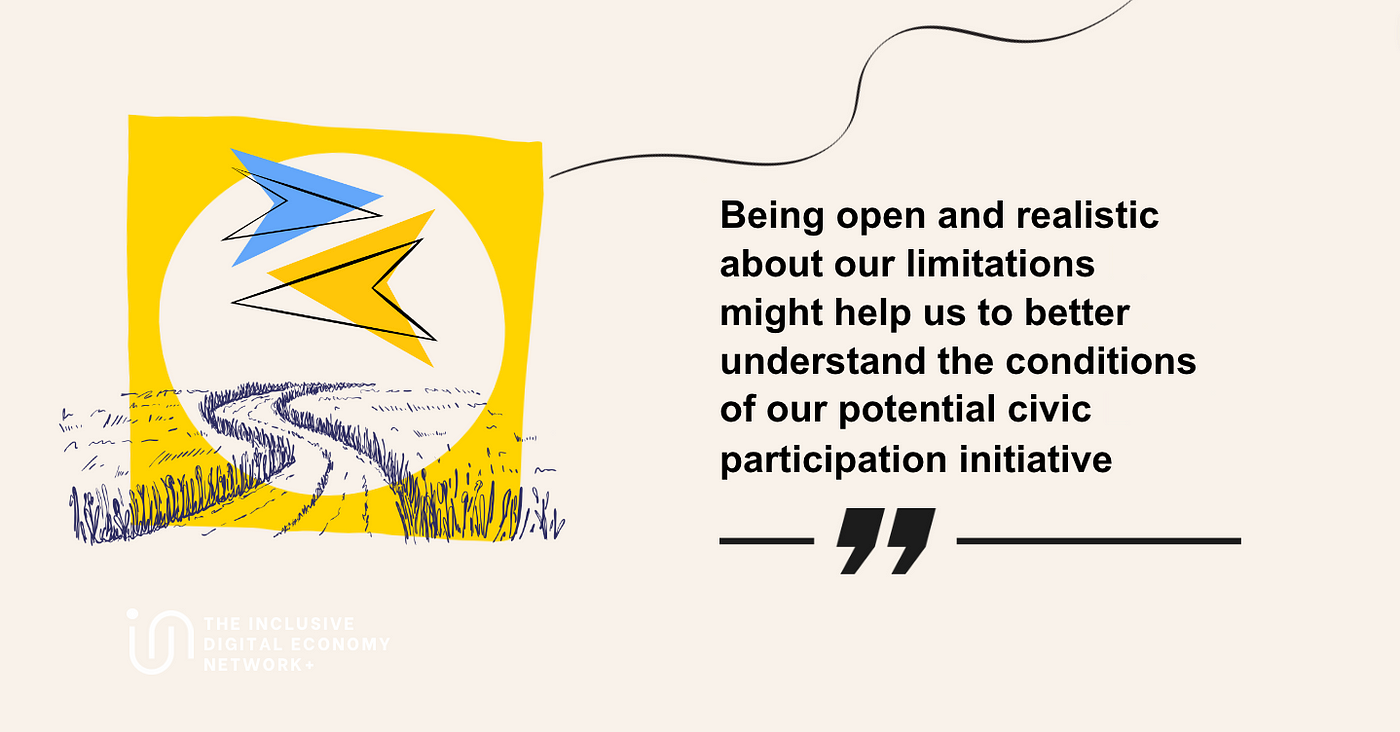Civic Participation is one of the key thematic areas being explored by the INCLUDE+ Network. Our 5-year programme aims to co-explore how/if meaningful civic participation can take place in digital times.

To better understand the existing civic participation landscape, we decided to carry out a horizon scanning activity — a future-oriented consideration and analysis of potential changes, opportunities, trends, and risks.
What is and what isn’t civic participation? What is the role of digital equity in civic participation? Our aim was to co-explore these questions.
In this post, we’re briefly covering some of our thoughts after our INCLUDE+ Civic Participation and Digital Equity Workshop, which was attended by representatives from the public sector, charities and NGOs.
Reality check: the assumptions, terms & conditions of [digital] civic participation
The power dynamics and ownership of participation and transparency were among the key topics discussed during the workshop. Who gets to set up and manage civic participation goals and agendas? Whose vision of participation are we focusing on and who benefits from possible impact?
Most (if not all) civic activities are situated within existing power dynamics — be it offline or online. Civic participation initiatives are often supported and funded by local authorities or NGOs, whose agendas and goals inform and regulate their purpose, pace, and potential impact agendas. This, in turn, might have an impact on the transparency, integrity, and ownership of the participatory process, as well as shaping our assumptions, terms and conditions of civic participation. If we have never been funded or supported to include certain demographics or to explore certain practices; if we regularly exclude certain topics or experiences, then our working explanation of what civic participation is and how it manifests will always have gaps.

To ensure that civic participation takes place in a mindful and transparent manner, it is important to take a step back and ask questions such as:
- What are our pre-existing assumptions about this civic participatory process?
- How are the different organisational factors (e.g., space accessibility, meeting times, food) affecting one’s participation?
- What practices do we (not) include in our own engagement?
Similar issues must be considered when talking about digital civic participation. There is a big difference between how people imagine and talk about the digital, and how they use digital technologies on an everyday basis. This is as much the case for organisations and facilitators as it is the case for communities with whom we work.
Digital participation comes with its own set of terms and conditions — which tend to be beyond our control
Civic digital participation is often situated within the opaque and inaccessible network of surveillance capitalism, whereby being/becoming digitally included often means being monitored, quantified, and having your ‘data self’ shared with third parties. It matters where you are engaging — if you are on Apps or platforms, on social media or on bespoke or local (e.g. council) forums. It matters how you are engaging — whether you are in a workshop with other people or on your own; whether you are creating or responding to material.

An example might include a person (let’s call them Alex) joining a local anti-racist Facebook group. Alex’ interactions with the group are affected by the level of their digital skills to be able to navigate the space in safe and informed ways; their connectivity (or lack thereof). Most importantly, Alex’ quality of digital civic participation will also be affected by factors way beyond our control — such as Facebook’s algorithmic curation of what Alex gets to see and when. Problems such as digital exclusion, digital poverty, algorithmic personalisation, online radicalisation (potentially leading to alternative and violent forms of civic participation such as with the Capitol Riot in 2021), bring about another set of power dynamics that needs to be considered in the context of civic participation.
The limitations of [digital]civic participation: adopting a critical, curious, and authentic approach
Being open and realistic about our limitations might help us to better understand the conditions of our potential civic participation initiative.

As our workshop participants suggested, it is important to take a step back and reflect on “the pre-participatory stage”. Instead of inviting people to participate in a pre-defined project, how about if we co-create spaces where people can simply come together and decide the goal of their work? Any planning related to the project objectives should also be grounded in a safe and inclusive setting, where a group of potential future participants gets to decide the topic they want to co-explore (and why).
Our INCLUDE+ workshop revealed that it is essential to situate our work within wider power dynamics (e.g., digital and non-digital; offline and online; and everything in between). Understanding and laying out our boundaries might provide us with important information as to what can be realistically achieved through civic participation. Being transparent about our position with the wider power dynamics, might also provide an opportunity for building an honest and trusting relationship with all people involved.

Finally, let’s acknowledge that the notion of participation isn’t power neutral.
Participation does not always lead to social change or empowerment.
Checking in with our assumptions about the process and its potential impact might be a powerful and useful exercise (during any stage of the civic participation process).
To be continued: scanning the civic participation & digital equity horizons
Moving forward (into INCLUDE+ Co-Defined Civic Participation Workshop 2), there are some key topics and questions that remain to be explored. Below are some of the questions we’re hoping to co-examine
- Who/what creates the value, terms and conditions of [digital] civic participation, and what can we do about this?
- How are existing socio-technological power dynamics affecting the process of civic participation, and what can we do about this?
- What factors and power dynamics need to be considered when planning [digital] civic participation?
- To what extent, are our own [digital] civic participation practices contributing to existing power inequalities (e.g., digital exclusion), and how could this be mitigated?
- What might be the core ethical values of [digital] civic participation?
- What are the minimum standards that need to be met to ensure one’s meaningful and informed [digital] civic participation?
- What are the differences between [digital] civic participation and [digital] civil disobedience?

— —
We would like to thank all INCLUDE+ Workshop participants for volunteering their time and sharing their expertise with us during the session. Special thanks to Thrive by Design for facilitating the co-creation process.
—
Author: Dr Alicja Pawluczuk (INCLUDE+ Research Fellow)
Images: all graphics were created by the author using Canva Pro.
